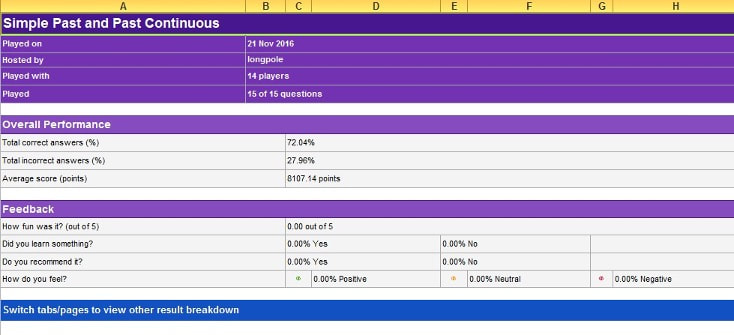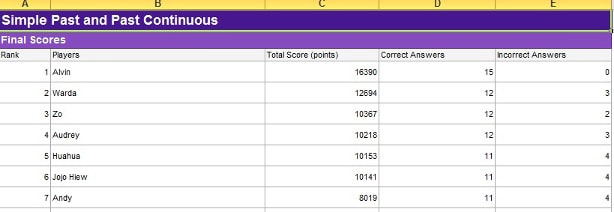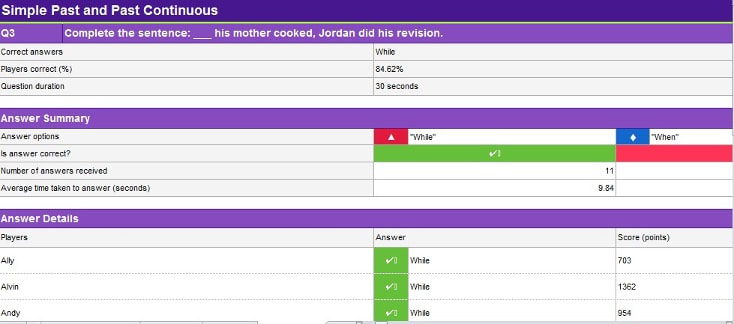Fun assessments? Exploring the use of Kahoot! to gauge students’ mastery at the end of a topic11/3/2020 by Perry Ronald Lim Summary The word assessment does not usually stimulate positive feelings in many people, be they students or teachers. Quite often, assessment is likened to a necessary evil; although not pleasant, it is something that has to be done. It is carried out to measure how well students have acquired the knowledge that our lesson plans say they have supposedly learned. Often times as well, such assessments are formal and tedious for both the teacher and the student. Is there some way, then, to make assessments less stressful for both parties; is it conceivable to even use the words fun and assessment in the same sentence? These questions begged an answer. This article attempts to show the viability of using Kahoot! as an exciting and invaluable tool for end-of-topic assessments. Kahoot! not only provides enough data for the teacher to make an informed decision on the direction of subsequent lessons, but also creates a thoroughly enjoyable environment while obtaining that data. Background and Context The use of technology in the classroom has been a long-time fascination for me. I have always been intrigued by the possibilities of what technology can bring to the classroom: how it changes the dynamics of the teaching-learning environment, and how technology allows material to be presented in a myriad of ways. Having said that, however, the use of technology in my own English language classroom has mostly been borne out of practicality. Technology allows me to reuse material repeatedly with only slight modifications to suit the learners I am teaching at any given moment. Thus, my use of technology in the classroom was predominantly for the presentation of learning materials through PowerPoint slides, videos, music, and the like. Occasionally, I would use Microsoft Word if I wanted students to provide some sort of input, such as an answer to a question. Any sort of assessment to evaluate students’ understanding was, more often than not, done through more traditional means – copied exercises, or through the exercises found in a workbook. I was well aware that assessing learning outcomes through technology was entirely possible. At various points in my teaching career, I was exposed to and had the opportunity to use software such as Authorware and Hot Potatoes – both very capable computer programs that have the capability to assess student learning. I felt the biggest drawbacks for both software, however, were the rather steep learning curve involved to use them, as well as the time needed to prepare an assessment. Also, individual student results still had to be collated and analysed manually which would mean more time needed just for assessing the learning outcomes of a particular lesson. The time-and-effort expense just did not seem a compelling enough reason to adopt technology for assessing students then. I was introduced to Kahoot! during one of the sessions in the Going Digital workshop in 2016 and I quickly saw how it could be used as a means to evaluate what has been learned. As a participant in the quiz carried out during the session, I not only enjoyed it tremendously, but the Kahoot! quiz also reinforced the knowledge about the TPACK model that had just been shared moments earlier. Kahoot! seemed to tick all the right boxes for what I wanted in an assessment tool – it was fun and engaging, and, most importantly, it seemed easy enough to set up. It appeared to have great potential for my own use in my classroom. Introduction – The Planning Stage I started using Kahoot! at the earliest opportunity possible. I had just finished teaching a group of 35 Form 4 students the imperative using the theme of music, and so, as part of my familiarisation with Kahoot!, I decided to create a short simple quiz. As the theme was on music, many of the questions in the quiz were on current songs and singers who students were very familiar with. A few questions on the imperative were also included. The outcome of carrying out the quiz was eye-opening: students were excited, and highly engaged with the material. What was even more impressive, however, was that the students seemed genuinely disappointed when the quiz was over. They were so taken by the whole experience that they asked if there were any more questions. At the end of it, I was not only able to get a better picture of how well my students had learned, but also actually made the whole process enjoyable. Double joy! Encouraged by the very positive outcome, I decided to use Kahoot! once more – this time in the more conventional sense of actually assessing learning outcomes. I wondered if students were going to be as absorbed in the activity when a more ‘boring’ topic was used as the basis for the quiz. While exploring Kahoot! a little more, I discovered that it was actually possible to obtain a more detailed analysis of students’ responses. This new-found facility piqued my curiosity on how useful the data would be. Thus, my objectives for the actual project were whether Kahoot! could:
The same group of students would be my target group as I would not need to provide any more explanation on how to play the game. Development Excited over the possibilities that Kahoot offered for assessment, I looked through my students’ work to decide on what my focus would be and noticed a common thread in a number of their essays: they had trouble in using tenses correctly, in particular, the past tenses. As the Sijil Pelajaran Malaysia (SPM) English Paper leans heavily on writing, and narratives are something that every student should be familiar with, I decided to concentrate on narrative tenses to give students the option of writing an easier type of essay with some confidence. To give my students a firm grounding of using such narrative tenses I chose the Simple Past and Past Continuous as my main focus with the option of including the Past Perfect later once I was satisfied that my students were able to use the Past Simple and Past Continuous correctly and consistently. I initially planned a series of four lessons to cover both the Past Simple and Past Continuous with the following emphases:
The lessons were to be carried out using my usual approach to teaching using a mix of PowerPoint slides, group discussions and exercises. In Lessons 1 and 2, the main objective of the lessons was to help students get a clearer picture of when to use each time of past tense while writing a story. Again, particular attention was given to sentence structure and the meaning of the sentence when such structures were used. The sentence structures taught essentially served as a kind of template that students could use when writing their stories. For example, if a student wanted to show an interruption to something that was happening in the story, then the structure would be something like this: In Lesson 3, I wanted students to create sentences on their own. I provided them the situations and they described each situation using the sentence structures that they had been introduced to in previous lessons. The concept of the timeline to them was introduced and I then proceeded to provide several examples of sentences that explained the actions in each timeline. For instance, for the timeline above the sentence that students would have to write would be: Maya was walking home when she saw a ghost and ran. The Kahoot! quiz used in Lesson 4 was developed based on what was done in the classroom with a particular emphasis on sentence structure, and meaning. I designed 15 questions that I felt would adequately assess students’ understanding and their ability to use the Past Simple and Past Continuous correctly. Implementation The end-of-topic quiz was carried out in the school library over two 40-minute periods as Kahoot! required an internet connection. I used the school’s Chromebooks and internet connection. Ideally, each student should have had his or her own Chromebook so that I could gauge individual performance, but from my past experience of using the school’s internet connection, I would need to limit the number of connections to ensure the smooth running of the quiz. Since this Form 4 class had 35 students, I decided to put students in groups of five which made seven groups. I also gave instructions that each student should take turns answering the questions individually after having had some discussion time although they were in groups. The students were ready and knew what to do having already played a similar quiz a few weeks prior. The quiz started off well, with each group member taking turns to answer the questions. However, as the game continued, and the competition became more heated, all manner of turn-taking was lost as each group wanted to be the first to answer so that they could obtain a higher score for each question. Reflection I set out with the intention of finding out if Kahoot! would provide me with enough data for me to determine how far my students had understood a particular topic that had been taught. I also wanted to know if that data could be easily analysed to help me decide what the next course of action would be: whether my students were competent enough in the said topic so I could move on to something different, or whether they were still struggling with certain concepts and needed a little extra time. The answer to both questions is a resounding yes! Just by the click of a button, Kahoot! takes away all the pain out of data gathering and data analysis. Downloading the game results data from the Kahoot! website in Microsoft Excel format yields the following data (please refer to Picture 1-4 in the Appendix):
The breadth and wealth of data that Kahoot! provides for every instance a quiz is played is something I appreciate very much. For my own class, I was able to pinpoint specific areas that my students needed extra help in (in this case, sentence structures used for the past continuous). However, I felt that the data would have been more helpful if individual responses could have been recorded instead of group responses. This shortcoming is not on the part of Kahoot!, though. As with other Web 2.0 tools, good internet connection becomes a crucial factor if a teacher wanted to incorporate such applications in the teaching-learning process. I am confident that, should limited internet connectivity be overcome, Kahoot! can be an effective tool in a teacher’s arsenal to do a simple yet effective assessment of students’ learning. Yet, the ability in assessing learning outcomes was not the only thing I found to be important when using Kahoot!. I also learned that the teacher has to think about what exactly needs to be assessed and how to actually design questions that actually test it. I found this to be especially time-consuming and not as simple as I had initially thought. As Kahoot! employs a multiple-choice question approach, the teacher has to pay careful attention to how the question is phrased and also to how make all the answer options plausible. Of course, the time and effort required to design a quiz vary according to the complexity of the topic being taught, but good question design should still be a major part of a teacher’s thought-process when using Kahoot!. If this seems like another burden, I feel it should not be. Designing valid questions that can measure progress is an essential skill any education should strive to have. When it comes to Kahoot!, the best thing is that you can reuse it over and over again, and students actually enjoy the whole assessment experience without even realising it. Revision - What’s next? While preparing the lessons in the lead-up to using Kahoot!, I more or less fell back to my conventional approach to teaching the Past Simple and Past Continuous. However, after having carried out the lessons and using Kahoot!, I think that my students still faced some fundamental problems in their understanding of the whole aspect of both these tenses as evidenced by their scores. Perhaps my approach to teaching needs to be modified. Sometimes, we do not provide a real enough reason for students to learn something, i.e. they do not see how a certain knowledge is beneficial to them so they do not actually learn it as there is no connection with what they actually need to do. I am considering using enquiry-based learning approaches to enhance the teaching of these tenses. Maybe show students a good sample essay and ask them to examine the sentence structures used, and from there lead them on to think about how they would write a sentence if they wanted to show, for example, an interruption while something else was in the midst of happening. This, I feel, would provide a genuine reason for them to learn as students would be able to clearly see why they need to learn how to write the sentence. Apart from revising my approach to teaching, I also hope to use Kahoot! as an integral part of my in-class assessment. I have found it to be an effective way to not only measure a student’s understanding of a certain concept, but also to test the more practical aspects of language skills such as forming sentences. I see the possibilities of integrating Kahoot! into lessons involving reading and even some aspects of writing. References / Useful Links Go here to see some examples of Kahoot! quizzes created by Perry and other participants of our previous Going Digital workshops. Published on: 3 November 2020 AuthorPerry Ronald Lim teaches at SM Shan Tao, Kota Kinabalu. He holds a B.Ed (Hons.) from the University of Kent, UK. He is an avid user of technology, so he regularly thinks of how technology can complement conventional language classroom practices to improve teaching and learning. He has been teaching for 18 years. He can be reached at [email protected] Interested in writing for us? Go here to send us a message!
0 Comments
Leave a Reply. |
Categories
All
|







